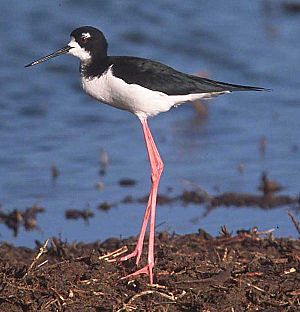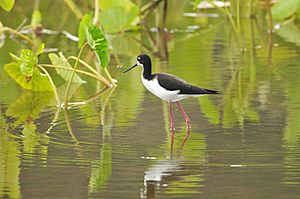Hawaiian stilt facts for kids
Quick facts for kids Himantopus mexicanus knudseni |
|
|---|---|
 |
|
| Conservation status | |
| Scientific classification |
|
| Kingdom: | Animalia |
| Phylum: | Chordata |
| Class: | Aves |
| Order: | Charadriiformes |
| Family: | Recurvirostridae |
| Genus: | Himantopus |
| Species: | |
| Subspecies: |
H. m. knudseni
|
| Trinomial name | |
| Himantopus mexicanus knudseni Stejneger, 1887
|
|
| Synonyms | |
|
|
The Hawaiian stilt (scientific name: Himantopus mexicanus knudseni) is a special bird found only in Hawaii. It's a type of subspecies of the black-necked stilt. This bird is easy to spot because of its super long, pink legs and thin, black beak. People in Hawaii also call it the aeʻo or kukuluaeʻo, which means "one standing high" – a perfect name for this tall bird! Sadly, the Hawaiian stilt is an endangered bird, meaning there aren't many left in the wild.
Contents
What's in a Name?
The Hawaiian stilt is usually seen as a special kind of black-necked stilt. Sometimes, scientists even think it could be its own unique species!
How to Spot a Hawaiian Stilt
The Hawaiian stilt can grow up to 38 centimeters (15 inches) long. It has a shiny black back that goes from its head all the way to its tail. Its forehead, face, and belly are bright white. Its beak is long, thin, and black, and its legs are very long and pink.
Male and female stilts look quite similar. However, the female often has a slightly brownish back, while the male's back is a glossy black.
These birds have some of the longest legs of any bird in the world! Their eyebrows, cheeks, chin, chest, and belly are all white. Young stilts have a brownish back and a patch on their cheek, similar to adult black-necked stilts. Baby chicks are tan with black spots, which helps them blend in with their surroundings.
Compared to other black-necked stilts from North America, the black color on the Hawaiian stilt goes further down its neck and face. Its beak, legs, and tail are also longer.
Behavior and Habits
Hawaiian stilts fly with strong, flapping wings, and their long legs dangle behind them. You can find them alone, in pairs, or in small groups.
They make a loud chirping sound that people describe as "kip kip kip."
Reproduction and Life Cycle
Hawaiian stilts build their nests in loose groups on flat, muddy areas near water. Their nests are simple, shallow dips in the ground, lined with small stones, twigs, and other bits of nature.
A female stilt usually lays four eggs. Soon after the chicks hatch, they leave the nest and follow their parents to find food. Adult stilts are very protective. They will bravely defend their nesting areas and even pretend to be hurt to distract any animals that might try to harm their nests or young.
What They Eat
Hawaiian stilts find their food in shallow water. They love to eat a variety of things like small fish, crabs, worms, and insects.
Where They Live
Most Hawaiian stilts, about 92% of them, live on the islands of Maui, Oahu, and Kauai. You can also find them each year on Niihau and Molokai, and sometimes on Lanai and Hawaii. They usually live in areas below 150 meters (490 feet) in elevation.
These birds live on all the main Hawaiian islands. They are quite common on Maui, O'ahu, and Kaua'i, where they still have breeding groups. They are less common on Moloka'i and Lana'i, and rare on Hawai'i. Many stilts from Kauai fly to Ni'ihau during wet winters. You'll most often see them in wetlands, like ponds, marshes, and muddy areas, especially near the ocean.
Protecting the Hawaiian Stilt
The Hawaiian stilt is listed as an "Endangered" species under the US Endangered Species Act. This means it's in danger of disappearing forever. In 1996, its conservation status was ranked as "globally secure" for the species but "imperiled" for the Hawaiian subspecies.
Good news! Since 1967, when it was first listed as endangered, the population of Hawaiian stilts has slowly been increasing. Between 1997 and 2007, surveys showed there were between 1,100 and 1,783 stilts.
Conservation programs are working hard to protect these birds and their breeding grounds. They are also trying to create new populations to make sure the stilts don't go extinct. The state of Hawaii and the US Fish and Wildlife Service have protected a lot of the state's coastal wetlands, which are important homes for these birds.
Dangers They Face
Like many native Hawaiian birds, the Hawaiian stilt faces many threats. Over the past 250 years, many animals have been brought to the Hawaiian islands. The biggest reasons for the stilt's population decline are the loss of their wetland homes and new predators. These predators include rats, dogs, cats, and mongooses.
Other problems include new plants and fish, bullfrogs, diseases, and pollution in the environment. Native predators like the pueo (Hawaiian owl) and black-crowned night heron also hunt them. The Hawaiian stilt used to be hunted for sport, but hunting waterbirds was banned in Hawaii in 1939.



